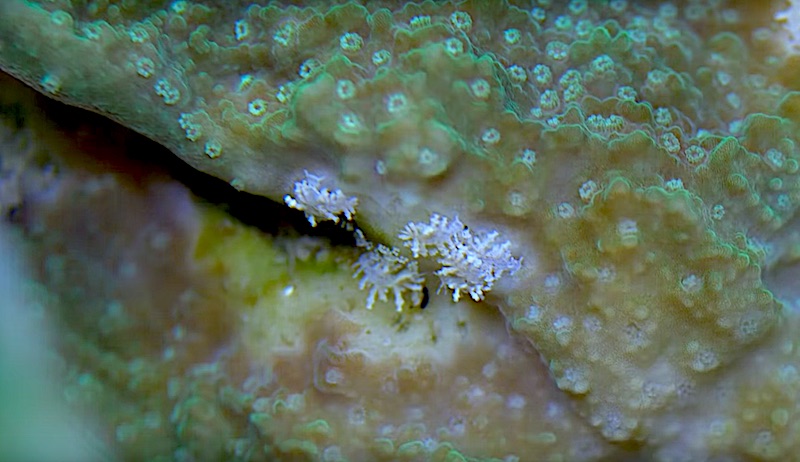Montipora corals are beautiful, fast-growing SPS species, but they come with a notorious risk: nudibranchs that feed exclusively on Montipora tissue. These pests are small, sneaky, and capable of wiping out an entire colony if not caught early.
What Are Montipora Eating Nudibranchs?
These nudibranchs belong to the Phestilla genus, and they’re true coral predators. Adult nudibranchs are around 2–5 mm long, white to cream colored, often with frilly appendages that help them blend in with the coral. Their camouflage makes them extremely difficult to spot, especially on plating and encrusting Montipora.
Worse still, they lay eggs—tiny coiled ribbons—on the coral, which hatch into new nudibranchs in days.
Symptoms of Infestation:
- Faded, patchy, or bleached areas on Montipora
- Rapid tissue loss
- Egg spirals on coral or frag plug
- Nocturnal activity: damage often appears overnight
- Visible nudibranchs when dipped
Like AEFWs, Montipora nudibranchs often go undetected until serious damage is done.
How They Spread:
Nudibranchs and their eggs arrive on new Montipora frags or colonies. Eggs are invisible to the naked eye unless you’re looking closely. They don’t move far, but once in your system, they can crawl to nearby Montipora pieces.
Treatment and Control:
1. Dipping
Dips like Coral RX, Revive, or iodine solutions will kill adults and juveniles, but not the eggs. Use a turkey baster to blast the coral during the dip to dislodge hiding nudibranchs.
- Repeat dips every 4–5 days for 2–3 weeks.
- Carefully inspect coral bases and plug crevices.
2. Manual Egg Removal
Scrape or trim affected areas. Eggs are sticky and often deposited in shaded or hard-to-see areas.
- Use tweezers or a soft toothbrush.
- Trim coral margins if necessary.
3. Quarantine
Isolate all Montipora in a separate tank during treatment. Monitor daily, dip on schedule, and remove any signs of re-infestation. Nudibranchs can survive on small coral fragments or slimes, so be thorough.
4. Natural Predators (Some Success)
- Yellow Coris Wrasse
- Sixline Wrasse
- Possum Wrasse
These fish may help reduce populations but should not be relied on as a standalone solution.
Prevention Tips:
- Dip every new Montipora frag or colony
- Inspect for eggs under magnification if possible
- Quarantine all SPS corals before adding to your display
- Avoid shared frag plugs or rocks when possible
Final Thoughts:
Montipora eating nudibranchs are a reef keeper’s headache, but they don’t have to be a death sentence for your tank. Vigilant dipping, egg removal, and quarantine practices can stop them in their tracks. As always: prevention beats eradication every time. Don’t just admire that new Monti—inspect it like your reef depends on it.
